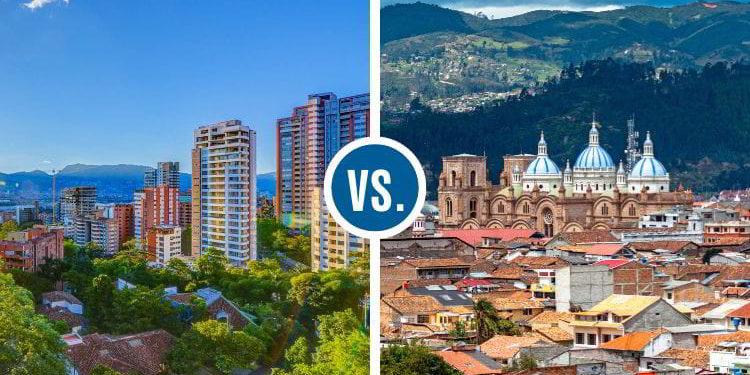I’ve spoken with lots of potential expats who are trying to choose between Cuenca, Ecuador, and Medellín, Colombia… even though these two cities are actually very different in key ways.
But, as I’ve lived in both places (and both are among my favorites in Latin America), I’m frequently asked to compare the two.
Let’s take a closer look…
Weather
Both Medellín and Cuenca enjoy great weather all year. My home didn’t have heat or air conditioning in either city, which saves a lot on the monthly budget.
But the weather is not the same, even though some describe them both as “springlike.” Medellín is warmer, with daily highs averaging about 82°F (28°C), with lows in the 60s, and only 1 degree of seasonal variation. In Cuenca, monthly average highs vary from 68°F to 72°F depending on the time of year, and nightly lows are also correspondingly less. I never broke a sweat in Cuenca and wore a long-sleeved shirt with no jacket almost every day of the year.
Rainfall is higher in Medellín (69 inches versus 35 inches in Cuenca), but so are the average number of sunny days.
So the city with the best weather will be a matter of your own taste.
The altitude of both cities is worth noting, aside from being the reason for their moderate temperatures. Medellín sits at about 5,000 feet above sea level (1,500 meters). Most people won’t notice the altitude unless they have respiratory problems that cause low oxygen levels.
Cuenca’s elevation is about 8,300 feet, or 2,530 meters. Almost everyone will notice the altitude on arrival, and then adapt to it after a time. Again, if you have oxygen-deficiency issues, Cuenca is not a good choice for you.
Residency
Residency is fairly easy to establish in both Colombia and Ecuador, with low thresholds for visa qualification in both cases. Both countries offer retiree visa options starting at about US$800 per month and investor options beginning at about US$30,000.
Colombia’s visa, however, is quicker and easier to obtain, with fewer required documents. Ecuador requires a criminal background check, for example, which Colombia does not.
Also, Ecuador has restrictions on being out of the country during your first two years of temporary residency, while Colombia has only token time-in-country requirements.
Ecuador’s visa is intended for people who actually live there, while Colombia’s will also work for those who are only in-country occasionally.
Both countries have a fast path to citizenship, with some options beginning after just two years as a resident.
Health Care
Health care is good in both cities and costs just a fraction of what the cost of comparable care is in the United States. Both cities have modern, first-world facilities and get high ratings from expats. While the quality of care in both cities is good enough to support a medical tourism industry, Medellín’s is more popular, diverse, and mature.
Culture
The cultural scene in Medellín is somewhat similar to that in Cuenca. This is surprising because Cuenca has about 600,000 people in its metro area, while Medellín has about 4 million. In both cities, you can enjoy orchestra, theater, art openings, museums, and a generally sophisticated cultural scene. It feels more sophisticated and world-class in Medellín, but I enjoyed Cuenca’s laid-back cultural scene just as much.
You’ll pay a fee for most cultural offerings in Medellín, while in Cuenca they’re usually free.
Infrastructure
The infrastructure is good in both cities. You’ll enjoy drinkable water, reliable broadband internet, and dependable electricity, water, and phone service at home in both Cuenca and Medellín.
Walkability is great in both places, and both offer excellent and cheap public transit systems.
If you decide to drive, you’ll find traffic jams equally maddening in both cities… although Ecuador’s drivers are far more rude, aggressive, and reckless than their Colombian counterparts.
Cost Of Real Estate
Real estate costs are cheap in both cities, even by South American standards.
That said, when comparing Medellín’s upscale El Poblado to Cuenca’s downtown, Cuenca is cheaper. On a cost-per-square-meter basis, El Poblado comes in at US$2,225 at today’s exchange rate, while Cuenca is down at US$1,456. (To put that into perspective, a nice neighborhood in Montevideo, Uruguay, will cost over US$3,000 per meter, while Santiago, Chile, comes in at US$3,280 per square meter.)
Even though it costs more to buy in Medellín than in Cuenca, I consider Medellín’s real estate market to be a good value, due to the generally high standards for construction and workmanship.
Given the lifestyle you’ll enjoy in Medellín, the real estate is a tremendous bargain. The same is true in Cuenca. For the lifestyle it offers, it is a bargain.
But the lifestyle in one is nothing like the lifestyle in the other. In fact, day-to-day living in Cuenca and Medellín are about as different as you can get.
In other ways, these two cities are very different…
(As Medellín is such a large and diverse city, I’ll confine my comparisons to its upscale, expat-favored neighborhood of El Poblado.)
Ambiance
Medellín’s El Poblado offers a lifestyle that is modern, upscale, and even luxury. It has elegant shopping, spotless infrastructure, glistening new buildings, and more fine dining than you can imagine. New, brick, luxury high-rises look down from lush, wooded hillsides. Tall trees line the clean, well-maintained streets. And El Poblado is only one of several such desirable areas in Medellín.
Cuenca, on the other hand, is one of the Americas’ premier Spanish-colonial cities and a UNESCO World Heritage Site. The old Cathedral was built in 1557, the architecture is well-preserved Spanish colonial, and the streets are cobblestoned. You’ll even see evidence of the Inca occupation from the early 1500s.
Yet just outside the historic center, Cuenca also offers new, modern high-rises. You could live in a modern home, yet have the historic center just within walking distance.
El Poblado is a First World environment; you’ll be hard-pressed to find a U.S. city that can beat it. Cuenca, on the other hand, is part of a developing country, where you’ll see some Third-World characteristics like broken sidewalks and poor building maintenance.
Accessibility
Access to the United States is easier from Medellín than from Cuenca. Medellín has daily nonstops to the United States, and the trip to Miami is three hours.
You’ll need to connect at least once when traveling from Cuenca (sometimes twice). The quickest trip from Cuenca today is to Fort Lauderdale, which takes over 10 hours with the connections.
Expat Community
The expat community is much more of a presence in Cuenca… especially on a per-capita basis. I can find expats in Medellín—at a local coffee shop or the Irish pub—fairly reliably, if I look for them. And a couple of Americans are signed up at my gym. But aside from the gym, I don’t see many expats around in my travels.
In Cuenca, there is a huge expat community of over 5,000 people, who are making a cultural imprint on the city. Their impact is generally positive, in my opinion.
Since the infusion of North Americans to Cuenca, there’s been an explosion in the number of nice cafés, restaurants, and book shops… as well as other expat-owned services and businesses. Today in Cuenca, you can find most everything you’d enjoy… and often find an English speaker to deal with. In Medellín, you’ll struggle if you don’t speak any Spanish.
But whether an expat community of that size is a positive or a negative for you will be a matter of choice.
Cost Of Living
The cost of living, as of this writing, is comparable in Medellín and Cuenca. But it won’t necessarily stay that way, as Colombia’s living costs (in dollar terms) are influenced by fluctuations in the exchange rate.
The dollar is strong by historic standards in Colombia right now, but this will change, of course, over time.
By contrast, Ecuador uses the U.S. dollar, so dollar-holders don’t feel the windfall of a strengthening dollar… or the pinch of a weakening dollar.
If the exchange rate in Colombia returns to 2014 levels, it will be noticeably more expensive to live in Medellín… although there is no way to predict if this will happen.
Neither city is expensive, though, so you don’t need to make this choice based on cost alone. You can afford to retire in both these great cities even on a very modest budget.
And The Winner Is…
There’s no winner. Neither city is better. Manhattan is not inherently better or worse than New Orleans, after all… but it’s a lot different.
The same goes for Medellín and Cuenca.
I see Ecuador as a cultural adventure. Living in this city is as different as you can get from living in the United States or Canada without leaving the world’s European-based cultures.
When I retired to Cuenca at age 49, I shunned places like Medellín, Chile, and Uruguay, because they were too much like America… I wanted something as different, enriching, and exciting as I could get, and Cuenca fit the bill.
Yet when I bought my place in Medellín, 10 years later at the age of 59, it was also exactly what I was looking for… a way to enjoy perfect weather and a sophisticated lifestyle that I couldn’t afford in the United States. By then, Medellín fit the bill for me perfectly.
You’ve heard a dozen times that the “perfect retirement location” is different for everyone. This is true, but there’s really more to it than that.
That “perfect spot” may also change with your tastes, your age, and your experience level living abroad.
If it does, you’ll find that the adventure and excitement of discovery need never stop.
Lee Harrison
20 years retired overseas…










